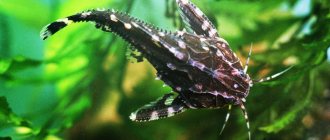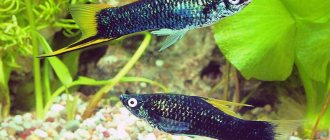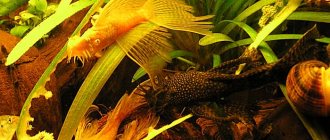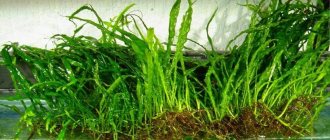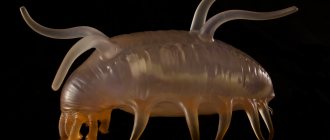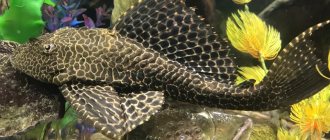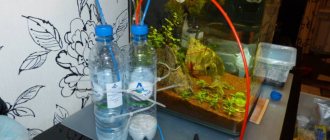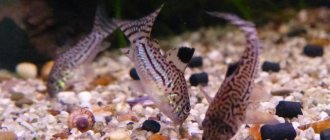“Cleaners”, “stickers”, “suckers” - all these names belong to one type of catfish - ancitrus. This, at first glance, awkward fish is popular among aquarists for its unpretentiousness and the benefits it brings to the aquarium. Before you buy this fish, study it carefully and look at the photo. Under its guise, they often sell catfish pterygoplichts or plecostomus, which grow up to 40 centimeters and can bring a lot of trouble to their owner.
Description
This catfish, like many other fish, was discovered in South America, and it came to us only after 1970. The fish got into home aquariums primarily because of its exotic appearance:
- due to its benthic lifestyle, the Ancistrus body has a teardrop-shaped, flattened shape;
- There are bony plates throughout the body designed to withstand predators;
- the color depends on the specific breed of fish;
- The main difference from other catfish is the shape of the mouth - it looks like a suction cup.
These fish do not grow too large - they reach a length of 20 centimeters. With proper care, they can live up to 7 years in a home aquarium, although in nature they most often die earlier.
Kinds
Ancistruses amaze with their diversity. The following types can be found in aquariums:
- Ordinary or blue - before puberty, the scales are distinguished by a bluish color, and then it becomes dark gray or yellowish-gray with chaotically located white spots.
- Veiled (Dragonfly) – The beauty of this Ancistrus is that its fins are overly enlarged. They flutter beautifully as they move around the aquarium. The body color of the fish is dark olive with small white specks.
- Yellow is another common species and has a yellow-orange body.
- Star-shaped - this species has a color so dark that small white spots stand out on it, like stars in the night sky. In young animals up to one year old, the fins are edged with blue, and in adults, small spines are visible on them.
- Starfish - differs from the previous type in its fins: the pectoral fins are thickened, and the dorsal and caudal fins are edged with white. When in danger, this fish releases hard spines from the base of its head.
- L-184 is the rarest catfish, it is also called diamond for its increased diameter of spots. The color of the fish is rich black, it does not change throughout its life.
- Red – this breeding species is suitable for those who prefer the fish to be active during the day. Ancistrus of this type has a red or slightly orange body color. Its size is small - up to 6 cm.
- Golden albino - the fish received a beige-golden color due to a genetic error; its scales are not pigmented. Another characteristic feature of her is the red tint of her eyes. The disadvantage of this catfish is its short life expectancy.
- LDA-016 - has an unusual brown color with dark spots, for which it is nicknamed the leopard look. With age, the contrast of its color becomes more noticeable. Sometimes gray spots can be distinguished on the body, in which case the breed is called brindle or tricolor.
Licensed species are expensive, so they are rarely found in ordinary aquariums. It is best to choose one of the types of ancistrus: yellow, veil or ordinary.
How to distinguish Ancistrus from Pterygoplichts
Chain catfish are similar to each other, so even at the purchase stage you need to be able to distinguish them. There are several signs that will allow you to choose the ancistrus:
- its young have a light edging on their fins;
- There are small horns on the top of the head, and no mustache on the bottom;
- many colors of scales;
- absence of a pattern on the scales characteristic of Pterygoplichthus.
Making the right choice is easy if you do your homework before purchasing your fish.
What are the options?
There are many varieties of sticky cleaners and each of them is individual. Many species are unique and inimitable. Among them:
Hypancistrus zebraHypancistrus zebra is a species unique in color. Having an almost exotic appearance, he is simple in maintenance and kind in character. A quiet life is his habit. Prefers almost twilight, a lot of green and strong plants, clean water, preferably heated to 30-31o;
Ancistrus diamondisAncistrus diamondis – a velvety black lump with bright dots , shimmering with a variety of diamond colors – a truly rare exclusive in the world of fish fashion;
Ancistrus super edAncistrus super red is one of the young species imported from Germany. The fish are bright orange in color, with transparent fins, which are framed along the contour by a bright red stripe. They differ from ordinary catfish only in color and, perhaps, in smaller sizes;
Ancistrus albinoAncistrus albino is a very gentle and unusual creature . Having a white or golden color and thanks to its wide fins, this Ancistrus fish looks like soft fluff that smoothly moves along the bottom, attracting everyone's attention.
But Ancistrus claro differs little from the usual Ancistrus in appearance, but is more inclined to change its natural reflexes depending on the environment. Thus, ancistrus easily replace their night life with day life, and their reclusive nature is diluted with interest in the world around them, including outside the walls of the aquarium.
Maintenance and care
It is easy to create suitable conditions for ancistrus:
| Parameter | Description |
| Shape and volume of the aquarium | Choose wide and long aquariums, with a volume of 80 liters or more when keeping a couple of fish. The bottom area should be maximum. |
| Filling the aquarium | You need to place a lot of decorations, shelters, castles, grottoes, and large stones in the tank. It is best to choose fast-growing plants that Ancistrus will use as feeding. For normal digestion, place natural driftwood on the bottom, which the fish can gnaw on. At the same time, it will give them a more attractive look. |
| Saturation of water with oxygen | The bottom of the aquarium has the lowest concentration of oxygen, so installing an aerator is mandatory. With it, catfish will not have to float to the upper layers of water, they will not be irritated because of this. |
| Temperature | In cool water (22-24 degrees), ancistrus are more comfortable, but in warmer water their growth stops prematurely. |
| Lighting | It is advisable to equip areas with constant shade in the aquarium, then the long daylight hours will not disturb the bottom inhabitants. If you were unable to create shaded areas, choose dim lamps. The easiest way to equip a shelter for ancistrums is to tie anubias to driftwood or plant them in an aquarium. |
| Daylight hours | The periods of day and night should be equal; when transitioning from one to the other, a half-hour twilight must be arranged. |
| Priming | It should not be too fine; smooth gravel will do. In search of food, catfish constantly feel the pebbles. If they are small, the fish will swallow them, and this will end in disaster. |
| Water renewal | Do not forget to organize a moderate flow in the aquarium and regularly change up to a third of the water in it to clean water. |
Reproduction
Breeding Gyrinoheilus catfish is almost impossible, since it is a troublesome business and requires a lot of labor. They are bred on specialized farms using hormonal injections, which are quite expensive and difficult to buy. But sometimes experienced aquarists take up breeding.
Sex differences
The sex of Gyrinocheilus can be determined during the spawning period. Females are visually larger than males, and in males a fatty tubercle forms on the head and the body color becomes brighter.
Spawning
Gyrinocheilus reaches sexual maturity in the second year. For breeding, you will need a special spawning aquarium of at least 200 liters with a separator mesh at the bottom and a filter that creates an average water flow rate. It is advisable to install the filter so that when spawning, the eggs are distributed over different parts of the mesh and washed with the current. It is also important to ensure good aeration, medium lighting of the aquarium and plant plants with large leaves.
Feeding
Ancistrus are vegetarians who prefer to obtain food on their own. They regulate the growth of algae and gnaw snags.
Additionally, they need to be given:
- industrial feeds, balanced for chainmail or based on spirulina algae;
- boiled greens: cabbage, lettuce or nettle leaves;
- fresh pieces of vegetables: broccoli, carrots, zucchini, cucumber.
Fresh pieces should be large so that the catfish can gnaw them. This is a very unusual sight. Cucumbers and zucchini are cut into slices, and broccoli is given as an inflorescence. Do not keep vegetables in the aquarium for a long time so as not to pollute the water. Use them as complementary foods. Give the main meals in the dark.
Can hold quite a lot
Males need to be provided with a sufficient number of shelters and a sufficient number of females. In our club, in 48-liter spawning tanks, there is one male and 3 females, but these are very comfortable conditions. If there are driftwood and living plants in the aquarium, then you can safely plant up to three dozen of the small species in the assortment in your jewelry. All kinds of simple and golden ancistrus, otocinclus, sturiosomes, loricaria, hypancistrus, etc. Unless, of course, you get carried away with aggressors like the star ancistrus.
Compatibility with other fish
If you create suitable conditions for Ancistrus, they will be peaceful and calm. The best neighbors for them will be fish with similar conditions:
- gourami;
- zebrafish;
- characins;
- platies.
Many people write that they get along with goldfish, but this is not so. Often, aquarists are faced with situations where catfish attach themselves to goldfish and tear off their skin along with the meat. Ancistrus can chase phlegmatic, slow or scaleless fish during periods of bad mood and start fights.
Also, you should not put two males, territorial breeds and cichlids in the same aquarium - such proximity will lead to fierce fights that can end in failure for everyone.
The structure of the mouth allows catfish to inflict fatal wounds, but at the same time, because of it, they coexist peacefully with shrimp.
How do they reproduce?
To prevent the eggs from being eaten by other fish, it is best to use a separate aquarium for breeding. Ancistrus ripen in about a year; you can pick a pair yourself and plant them. For a maternity tank, choose an aquarium of approximately 50-60 liters. Fill it 2/3 with water from a common container and 1/3 with clean water. Set the temperature 2 degrees lower than in the main aquarium.
The only difference in the design of the spawning tank is that it must have a special shelter for spawning. You can make it yourself by fashioning a tube out of clay, or buy a ready-made piece of pipe or a piece of driftwood that is hollow inside. Such shelter is necessary, otherwise the female will leave eggs in the most unexpected place. There were cases when she threw it into the filter.
The male chooses the place for the offspring; he can do this for several days. The future nest will definitely be thoroughly cleaned, after which the process of courtship and spawning will begin. Most often, the female lays eggs at night; in the morning they should be immediately deposited back. Parental functions are performed by the male; he can even drive the mother away from the nest at this time.
On the 5th day the larvae hatch, but for another week they will gain strength in the nest. When they begin to move independently, the male loses interest in them; he has fulfilled his paternal functions. At this time, it can be returned to the general aquarium, and the fry can be fed with special tablets for catfish three times a day. Catfish can be transferred to a community aquarium at 6 months.
How to distinguish a male from a female
Male ancistrus can boast of clearly expressed sexual characteristics - there are numerous growths on their upper jaw. They are often called mustaches, beards or horns.
It is interesting that females find these growths attractive; they give preference to those males in which this dimorphism is most pronounced.
A less noticeable feature is the size of the body: males are larger, but at the same time more graceful. Girls have a more rounded abdomen, and growths on the upper jaw are only 1 mm long.
So that they don't feel crowded.
. they got into SO many fights, especially over the place where the food fell, that they simply feared for their lives.
A ninety-liter jar is most likely not enough! Your bottom is about 50 by 35 cm, and for ancistrus (pairs) this is quite cramped, especially if they are potential dads. With a small bottom area, it is advisable to make several transverse partitions (cut up the relief) up to 5-8 centimeters high and feed them separately so that they do not see each other when feeding.
. the second (larger) is alive and well, the younger one has been living with him for a year now, or rather the younger one, he doesn’t push her around very much. True, more because he sits under a snag all the time and is afraid to get out.
Interesting observation. Yes, she is not afraid, but respects subordination.
So how many antsisters can live in Yuvel-96 without being overcrowded?
As for shelters, S.Yu. is absolutely right; dad needs a pebble or a cave where he can hide from his terrible owner. But, even on the bare bottom, he manages to abstract himself from the harsh reality, although it is advisable to bury his head in something.
Source
Content issues and helpful tips
Experienced aquarists believe that ancistrus are easy to keep. You may encounter only minor problems:
- An incorrectly chosen aquarium can lead to manifestations of aggression in catfish, even within their own species. They will guard their borders and not allow others in even to get food. It is best to have at least 40 liters of water per ancistrus.
- Since fish are active at night, they may not behave very friendly at this time. They climb onto the backs of sleeping individuals and gnaw their scales.
- Often this bottom-dwelling fish finds itself in the upper layers of water. In this case, increase the air supply by adjusting the compressor. Frequent ascents are dangerous because the catfish can climb into the filter (especially before spawning) and die there.
- There are several groups of diseases that catfish are exposed to: bacterial, viral, digestive disorders, worm infections. Regularly monitor the condition of your pets so that if there is the slightest change, remove the catfish and treat it.
It is interesting to observe the unusual habits of the ancistrus, especially during its games or feeding. If you follow the recommended conditions for keeping your pet, he will become a happy long-liver.
Diseases
Ancistrus catfish are not in poor health, but some diseases also affect them. A common cause of disease is failure to maintain cleanliness and hygiene of the aquarium, untimely change of water, and rotting of food particles stuck between stones. Therefore, the best prevention of diseases in the aquarium inhabitants is timely cleaning and replacement of water.
In order to promptly determine the deteriorating health of ancistrus, you need to monitor the condition of your pets every day. If you recognize the disease in advance, it can be easily cured.
Symptoms of a sick catfish:
- Unusual behavior, uncharacteristic actions. Sluggish and inhibited or overly active behavior in combination with other symptoms indicates some kind of disturbance in the body.
- Change in fish color. More often the yellow color fades and loses its brightness. But this also happens after the spawning process, so this symptom is inaccurate.
- Poor appetite or its complete absence. Healthy fish are always ready to feed and swim to the place of food. And the patient remains in the shelter and does not touch the food.
- The formation of unhealthy plaque on the skin and scales.
Fish with one or more symptoms are separated from the others. Most often, catfish are affected by fin rot, swim bladder disorder and bacterial diseases.
